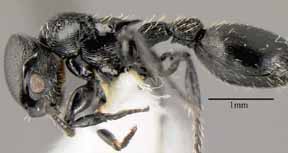

Formicidae, Hymenoptera, Insecta, Arthropoda, Animalia
|
|
|
Image catalogue, holotype worker (click here).
Range
Costa Rica, Panama.
Description of worker
Holotype worker measurements: HW 1.279, HL 1.242, SL 0.710, EL 0.352, MeL 1.562, MeW 0.925, PrW 0.666, PrL 0.450, PrS 0.222, PrT 0.672, MTL 0.881, PtL 0.509, PtW 0.341, PpW 0.450, PtH 0.367, AL 1.537, AW 1.210, ASW 0.026.
Additional worker measurements: HW 1.16-1.31 (n=3); MFL 0.874, MFW 0.326 (n=1, Panama).
Face sculpture shallow; face to vertex margin with evenly dispersed discrete foveae, distance between foveae subequal to fovea diameter; interspaces subopaque, with fine areolate etchings; short, subparallel, longitudinal rugae on posteriormost one sixth of face, at vertex margin; clypeus weakly bent ventrad, anterior margin with a semicircular impression from which a median tuft of small setae emerges; clypeus weakly longitudinally striate; genae longitudinally striate; genal bridge longitudinally striate; mandible longitudinally striate; scape flattened as in P. attenuatus, as wide at base as at apex; flat surface of scape with microareolate sculpture; vertex margin sharply angulate and somewhat crenate; vertex almost entirely smooth and shiny, or with variably developed longitudinal striae medially and laterally; eye shallowly and evenly convex.
In dorsal view, anterior and lateral margins of promesonotum evenly rounded; mesonotum with lateral lobes which have straight lateral margins nearly parallel to the longitudinal body axis, meeting flat posterior margin at slightly less than a right angle, weakly projecting; propodeum with shallow lateral lobes which extend approximately half the length of the dorsal face; mesosomal dorsum longitudinally striate over most of surface, becoming somewhat irregular and with a few foveae at anterior margin of pronotum (striae extend to anterior margin on Peru specimen); propodeal suture deep, V-shaped in profile, breaking longitudinal striae that cross it; posterior face of propodeum perpendicular to dorsal face, slightly concave, completely smooth and shining; dorsal and lateral faces of pronotum meet at an angle; lateral face somewhat concave, smooth on upper half, coarsely longitudinally striate on ventral half; anepisternum striate; katepisternum striate with variable amount of upper portion smooth; lateral face of propodeum somewhat concave, smooth on upper half, coarsely longitudinally striate on ventral half; coxae smooth or with variable presence of weak striae; hind femur strongly swollen medially, spindle-shaped; outer surfaces of tibiae coarsely rugose, subopaque; posterior face of forefemur smooth and shining or with a few oblique rugulae at upper distal margin.
Petiole subcylindrical, longer than high, with a weakly convex posterodorsal face; ventral margin weakly concave with a low, blunt anterior tooth; postpetiole with a long, gently sloping anterior face, and a broad, rounded summit near the posterior margin; ventral margin short, with a prominent, acute anterior tooth; anterodorsal face of petiole curved posteriorly, smooth and shiny; posterodorsal face of petiole and postpetiolar dorsum coarsely longitudinally striatorugose; first gastral tergite longitudinally striate, underlain with microreticulate sculpture to give slightly granular look, striae fading to leave narrow smooth band at posterior border; first gastral sternite with anterolateral patches of oblique rugulae, remainder with microreticulate sculpture and sparse piligerous puncta; second gastral tergite with microreticulate sculpture and a few weak rugulae laterally;
Dorsal setae short, stiff, somewhat flattened, yellowish; face nearly devoid of setae, with 1 or 2 near margin of vertex; promesonotum with clusters of about 6 on humeri and a pair near lateral lobes; pair of converging setae in propodeal suture; dorsal face of propodeum with about 10 setae; relatively denser and longer setae on petiole, postpetiole, and on first gastral tergite near postpetiolar insertion; setae sparse and short on rest of first gastral tergite, becoming longer at apex of gaster (setae on thorax and abdomen more abundant on Peru specimen); first gastral sternite with sparse subdecumbent and decumbent setae; color entirely shining black.
Description of queen:
Paratype queen measurements (barcode LACM ENT 141602): HW 1.285, HL 1.240, SL 0.688, EL 0.384, MeL 1.718, MeW 1.029, MTL 0.865, MFL 0.933, MFW 0.339, PtL 0.549, PtW 0.341, PpW 0.463, PtH 0.359, AL 1.696, AW 1.315, ASW 0.035.
Similar to worker except for traits typical of caste. Pronotum smooth medially, irregularly foveate-rugose laterally; mesoscutum, axillae, and scutellum longitudinally striatorugose, interspersed with evenly dispersed foveae; dorsal face of propodeum longitudinally striate.
Natural History
This species is an inhabitant of montane wet forest. All records are from workers and dealate queens collected from low vegetation or treefalls.
Types and Synonymy
Procryptocerus kempfi Longino and Snelling 2002:18. Holotype worker: Costa Rica, Prov. Heredia, 17km S. Puerto Viejo, 10¡18'N 84¡02'W, 600m, 24.i.1989, wet forest, on low vegetation (Longino #2300-s) [INBC]. Barcode: LACM ENT 141719.
Comments
Longino and Snelling (2002) report P. kempfi from Peru. This is an error due to my early misidentification of a Peruvian specimen of P. subpilosus as P. kempfi. The two species are very similar, differing only in the base of the scape. It is flattened in P. kempfi, tapered and rounded at the base in P. subpilosus.
Page author:
John T. Longino, The Evergreen State College, Olympia WA 98505 USA. longinoj@evergreen.edu
Date of this version: 10 December 2002.